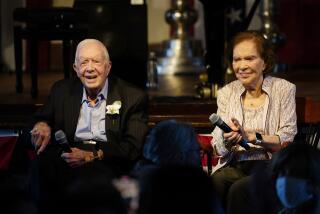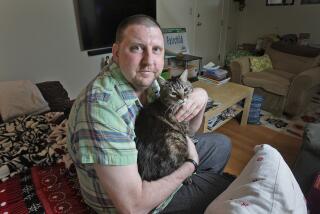New Study Shows That, for Elderly, Resuscitation Usually Fails, and May Extend Suffering
- Share via
The elderly man has collapsed in the street. He isn’t breathing and his heartbeat is erratic. One bystander rushes off to call paramedics, while another begins the lifesaving technique he learned in a weekend class, cardiopulmonary resuscitation.
This steady external massage of the chest, alternated with forcing air into the lungs, may help the old man. If he is lucky, his heart and lungs will start working again and after a few days in the hospital he’ll be sent home.
But, if he is not so lucky, CPR will doom him to spend days, weeks or months in a hospital’s intensive care unit--where he will die anyway. Or if his brain was deprived of oxygen for too long, he’ll leave the hospital in a coma or demented.
Indeed, a study published in today’s Annals of Internal Medicine puts some numbers on this tragic twist of fate that doctors say is all too common.
Life-Saving Statistics
The Massachusetts study of 503 people over age 70 who received CPR found that 112 of them were revived initially, but only 19 lived to leave the hospital. Of those, eight were well enough to go home. The rest faced a future in a nursing home or a rehabilitation hospital; two were severely debilitated, one in a vegetative state and the other severely demented and totally dependent.
These results point out what some doctors have been saying as CPR approaches its fourth decade of widespread use: That a technique that is routine in hospitals and on the street is medically inappropriate, even inhumane, to deliver to some patients, many of them elderly.
Across the country, doctors, bioethicists, hospital administrators and patients’ rights groups are tackling this issue, trying to figure out when “do not resuscitate” orders should be issued and who should be involved in making the decision.
“It’s basically the Golden Rule,” said Dr. Donald J. Murphy, assistant professor of health sciences at George Washington University in Washington, D.C., and principal author of the study published today.
“How can we so willingly resuscitate an 80-year-old woman who’s trying to die at home when the vast majority of health-care providers who are aware of the implications of CPR would refuse that treatment for themselves?” Murphy asked.
Ideally, CPR should be started within five minutes of the time that breathing and the heartbeat stop, to prevent irreversible damage to the brain and nervous system from lack of oxygen. Damage seems to occur more easily in the elderly, doctors say, though no one is sure if age itself or the illnesses that accompany aging are to blame.
Firmly planted at one extreme in the “do not resuscitate” debate, Murphy takes the controversial stance that doctors should issue DNR orders for certain patients in nursing homes and hospitals without consulting either the patients or their families. Doctors are under no obligation to inform patients about medical therapies that are futile, he wrote in an October article in the Journal of the American Medical Assn.
The idea is being talked about so much in the medical community that the prestigious bioethics think tank, the Hastings Center, is including a discussion of it in an educational program it is developing for hospital officials, said Dr. Kathleen Nolan, associate for medicine at the center.
“A lot of clinicians agree with him because I think he speaks for their desire to avoid giving useless care,” Nolan said of Murphy. “Clinicians do hate to fail, and (CPR on extremely ill patients) sets them up for failure. I think they also don’t like talking about these issues with people. But within the bioethics community there’s much greater resistance to the notion.”
Nolan is among those who concur with Murphy that CPR is being done on too many people, but who disagree with his proposed remedy. They say doctors of seriously ill patients should talk to them or their families about the minimal chances for a successful resuscitation, and let the patients or families decide.
“CPR should be less frequently used but it should be less frequently used because patients have assumed more of a role in their own care,” Nolan said. “What I would like to see is for people to have more control of all medical interventions at the time of the death.”
Survival after resuscitation for all age groups is not as good as might be expected after more than 20 years of promotion of it by the American Heart Assn. and the American Red Cross. In the 1987-88 fiscal year alone, the Red Cross certified 2.5 million Americans to perform CPR.
In hospitals, where the chances of being revived by CPR are greatest, the procedure is performed on one-third of the patients who go into cardiopulmonary arrest. Ten percent of these people receiving CPR survive to leave the hospital. Two percent of the survivors are left in a persistent vegetative state.
Overall, it is the otherwise healthy victims of traffic, drowning or other accidents who are among the few CPR recipients who eventually can go on to lead normal lives.
Paramedics and emergency room doctors know from experience as well as research that, for an elderly patient from a nursing home, revival by CPR will most probably doom the patient to days or weeks in an intensive care unit, after which he will die anyway. Yet half of the in-hospital CPR attempts in this country are done on people older than 65.
Murphy said that his own experience talking about CPR with about 200 nursing-home patients in Boston found only two who wanted to be resuscitated--a concentration camp survivor and a former professional boxer.
Best Interest
For that other 198, he says, performing CPR on them not only would go against the patient’s best interest but also would fill scarce critical-care beds with people who have virtually no chance of surviving.
Nonetheless, even those who acknowledge this problem are largely unwilling to abandon resuscitation attempts without getting a patient’s or a family’s consent.
“As more and more elderly patients with chronic illnesses and severe dementia fill beds in long-term care facilities in the decades ahead, the problem may become monumental. . . . (But) until we reach a public consensus about how to deal with these very difficult issues, individual clinicians and institutions should continue to separate concerns about patient welfare from broader social and economic policy issues,” wrote Dr. Stuart J. Youngner of Case Western Reserve University in a response to Murphy’s October article.
Dr. Paul Miller, a Covina physician and vice chairman of the CPR Committee of the American Heart Assn., said that the association’s first booklet on CPR promoted it only for use in “sudden unexpected death.” With that as the standard, roughly half of all CPR attempts in the late 1960s and early 1970s gave good results, he said.
The nose dive in success rates since then is a result of it being done to virtually everyone, he said.
Dr. Robert Hockberger, director of emergency medicine at L.A. County Harbor-UCLA Medical Center, said resuscitation is attempted on all emergency patients there unless doctors know that the patient doesn’t want it, has a terminal, incurable disease or is in a chronic vegetative state.
But emergencies by definition often don’t let a doctor know such information, and a doctor can’t tell just by looking at someone that CPR won’t work well, Hockberger said. “When you haven’t been breathing for 15 minutes, you don’t look good even if you’re 35 years old,” he said.
“The very nature of resuscitation is that if it’s going to be useful at all, it’s got to be started within the first three or four minutes of the time the heart stopped, and that doesn’t give you a whole lot of time to investigate all of these possibilities,” Miller said.
“Our job is to preserve life. If you’re going to err in one direction or another, I think most of us feel that we’d rather err on the side of trying to save a life, knowing that sometimes it may have been somebody who was not a good candidate,” he said.
Influencing the Debate
One also has to be careful about “ageism” influencing the debate with assumptions that just because someone is old, they must be infirm, doctors said.
“It becomes a question of which elderly,” Miller said. “I’m concerned about putting an absolute age limit on it.”
“The real question is whether CPR does any good or not,” said Dr. Marshall Morgan, director of emergency medicine at UCLA Medical Center. “Of these 500 people that were attempted to be resuscitated, 10 of them are at home. Ask one of those 10: Would they be happier if nobody had tried to resuscitate them? It’s a matter of whether the glass is half full or half empty.”
The most responsible solution to futile CPR attempts, many believe, is for physicians to talk to their elderly or chronically ill patients in advance about just how far doctors should go to save their lives.
Murphy said he believes that for the most part that won’t happen, because doctors and families are uncomfortable talking about such issues.
But patients, too, can bring up the subject, and they ought to, said Sandra Sweeney, manager of special projects for the American Assn. of Retired Persons.
“We would encourage people to discuss this sort of thing with their doctors and with their families,” Sweeney said. “We would encourage them to think through what their own feelings are about these life-and-death issues. They should really be very specific: ‘I don’t want a respirator, but I do want food and hydration.’ ”
The living will, which specifies a person’s health-care preferences but generally applies only if the person is terminally ill, is recognized as legally binding in 40 states. (The 10 that don’t have living will laws are: Kentucky, Massachusetts, Michigan, Nebraska, New Jersey, New York, Ohio, Pennsylvania, Rhode Island and South Dakota.)
If a person feels strongly that CPR and all other medical measures should be taken to preserve life, that too can be specified in a document known as a durable power of attorney, Sweeney noted. This option is available in all states and is applicable also in non-life-threatening situations such as incapacity caused by a stroke, she said.
RESULTS OF RESUSCITATION Despite the advent of cardiopulmonary resuscitation (CPR), 400,000 to 600,000 persons die every year in the United States from sudden cardiac arrest.
CPR was first described in medical literature in 1960. Since then it has become standard therapy delivered by emergency medical personnel and informed bystanders.
Among the general population, its success, defined as the patient leaving the hospital alive, has been reported as high as 30%, but generally it was about 10%.
Among the elderly and some extremely ill persons (such as those with pneumonia or kidney failure), studies show the success rate of CPR is almost nil.
A study published today in the Annals of Internal Medicine considered 503 patients age 70 or older who received CPR. Results of the study:
Initial survivors--112 (22%) Survivors discharged from hospital, only two of whom had cardiac arrests outside the hospital--19 (3.8%)
Survivors with no physical or mental damage--9 (1.8%)
Survivors severely demented or totally dependent--2 (0.4%)
Successful resuscitation attempts on elderly patients are extremely rare if: The cardiac arrest occurred outside a hospital . . .
or the patient had several acute or chronic health problems . . .
or the resuscitation attempt lasted more than 5 minutes.
The elderly, and anyone else who feels strongly about what kind of medical procedures should be used on them, are advised to take steps in advance of illness to assure their wishes will be met.
A free booklet on such issues, “Tomorrow’s Choices,” is available in single copies from the American Assn. of Retired Persons, Fulfillment, 1909 K St. NW, Washington, D.C. 20049.
SOURCE: Annals of Internal Medicine, Aug. 1, 1989.






